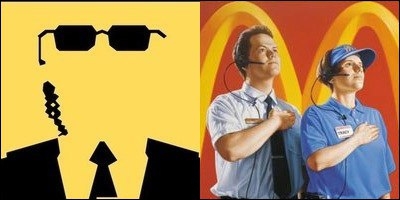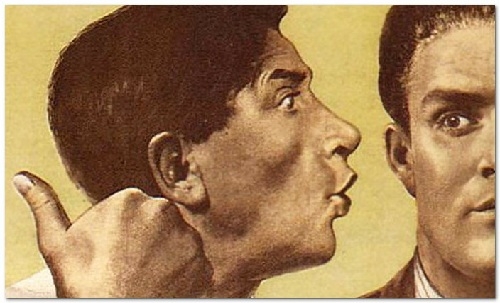Low price - not the main advantage or how to hook, if not price?
- Tutorial
We analyze how to attract new customers, not relying solely on the low price. 9 main factors affecting the attractiveness of a proposal.
I don’t know where this “secret knowledge” comes from, but almost every “beginner” considers it his duty to “crush” the price of his competitors. Is it a successful idea to “crush” at the cost of all circumstances? Let's analyze some aspects of marketing that will allow you to abandon too low prices.
Each person has values formed under the influence of external circumstances that affect his choice. That is, each group of people has its own understanding of what is their advantage and what is not. Despite this, almost everyone judges by themselves: I take what is cheaper, which means everyone does it.
In addition, people's priorities are variable and often change, depending on the situation.
The list may be endless, but I will try to express the most common variations of what customers are guided by (their priorities at the time of decision making) when choosing the place where they will buy the goods they need (chaotic order):
If you still want to “crush” the price - be prepared for serious losses and powerful confrontation from competitors.
By the way, a price war is a war in which there are winners: customers will be very glad that you have started all this, because they will be able to purchase their usual goods at a price lower than usual. The downside is that this is a serious risk: it is difficult to predict the reaction of the consumer.
If we are talking about a product - everything is simple. The customer compares prices for a particular product among several stores and selects the best offer. There is a really low price, as they say, "solves".
When it comes to services, things get more complicated. Perhaps you noticed that the price of the same service in different places is very different? Something obscure is going on: prices take what is called "from heaven."
I have an example of guys who have two sites. The service is the same (creation of landing pages), but on one site the price is 30 thousand rubles, and on the other 110 thousand. Under such circumstances, it is not necessary to say that you need to “push” the price, especially if the market is saturated.
It’s not necessary to set the price at 1 ruble in order to interest the client?

The high quality of the product should be combined with a good presentation: you have yet to prove to the client that your quality justifies the price that you offer.
It’s not necessary to give the customer a “touch” on the quality of your product - just give him the opportunity to imagine that he has already done it. A good description of the benefits of a product can be given to him in such a way, in which you can clearly demonstrate why “this” quality costs “this” money.
Read more about product presentation methods here .
If the quality is poor - change the quality, or change the price. Better first: quality should be not only pictures on the site. If your product is falling apart in pixels - it's worth considering.

A lot of promises, complex (read “abstruse”) words, confusing explanations with a bunch of reservations - a sure way to destroy simplicity and clarity. Better write as it is, even if it does not put you in the best light.
If "as is" exposes you in a very bad light, then lying to customers is all the more not an option. Improve your “as is,” rather than embellish it. Clients are not robots - they understand and appreciate everything perfectly when they are not trying to deceive them from the very beginning.
Warranties, simple and understandable descriptions, the absence of "stars" are a good choice.
Clear descriptions should clearly demonstrate the properties of the product and, most importantly, convey the emotion of the product. For descriptions, you can use text, infographics in images, and promotional videos. If you want to convey emotion at the same time and demonstrate the advantages of the proposal, I do not recommend using the text, as it conveys emotions extremely inefficiently.
In addition to emotionality, it is important not to look suspicious in the eyes of the client.

There are so many subtleties and components. For each area of activity there is a definition of what is a good service. Although, there are the most basic properties of a “good service” that apply to any field:

Everything is simple here: the “fatter” your cases are, the higher your confidence is in you, because large customers would not turn to a bad company, right?
But not everyone has the opportunity to receive an order from Gazprom-Media.
It’s enough to use ordinary reviews. Again, artificial reviews should not be used, because it immediately shows that they are artificial. In combination with poor evidence of the “reality” of reviews - this gives only the opposite effect.

After working with a client (whether providing a service or selling a product), just ask him to leave a review. If the review turns out to be bad - do not rush to delete it. This is a simple but incorrect solution. Better take the feedback and use to improve your product.
If we are talking about a product, then offer a bonus to the client as compensation so that all those people who will watch reviews can see that you are ready to compensate for the inconvenience and work on yourself.
Your customers can be great ads. If people around you see that many use your services / consume your product - your chances increase. This is called "social confirmation." It is very important for people to see that someone is already using your services, and that they will not have to be pioneers.
A good example is some kind of soda. The label is glued so that the hand does not block the logo when holding (if the person is right-handed).

Or cigarette packs. Because of their design, people have to get a pack to take a cigarette. Thus, others see which brand of cigarettes you prefer.
It is worth noting that at least each person has his own concept of “beauty” - there is some general tendency to sympathy for certain elements, inherent in each individual group of people. Find your group of people. Some call it their "target audience." You yourself must decide what your target audience preferences are to enjoy. You cannot please everyone, but you can please a specific group of people.
A simple example: kittens. Almost everyone loves kittens, so they are actively used to beg the favor of the audience.

Again, social confirmation. The difference is that in the case of acquaintances, it works more efficiently than in the case of strangers, because if you know a person, then you have a formed opinion about how much your tastes and values coincide.
Word of mouth - everyone knows how it works.

9. A certain "character" of the brand
The “character” of the brand includes everything that is described above, not to mention that it was not described at all. In the framework of this article, I can only add that the feeling of “property” (feeling “your”) is very important for the client.
Well, you know, when you bought one of the products of your favorite brand and you feel that you are “yours”. As if you are a part of a brand, and a brand is a part of you, and he, too, is supposedly “your boyfriend”.
Explained so explained, but ... Marlboro coolly raised sales when the Americans got the associative link "Marlboro-coolness, cowboys."

Or “Beer for Real Men” - this also creates associations for men: “I drink this beer like a real man.”
This may not seem to work, but it works.
As you can see, there are plenty to choose from
Crushing by price is the most “clumsy” and expensive method that does not always work. It is worth noting that not every entrepreneur is able to compete with large players in their niche, which due to good turnover can afford extra costs and set an impossible low price.
If you set a price that you simply cannot afford - you can put all your things (cactus and framed photos) in a cardboard box and leave the market.
You need to set the price that will bring you a net profit, and not endless revenue. Of course, if you are not “Uber” (There is a general, but there is a particular. So I am interested in most cases, but not particular ones).
This does not mean that you need, to put it mildly, “keep in mind” the pricing policy in the market. In any niche there is a gap between the maximum and minimum prices among competitors, and in order to “move” the framework of this gap to the larger side, it is necessary to have good reasons in the form of several advantages.
If you have a desire to help us improve the quality of content and / or correct the author - write to me or leave comments;)
I don’t know where this “secret knowledge” comes from, but almost every “beginner” considers it his duty to “crush” the price of his competitors. Is it a successful idea to “crush” at the cost of all circumstances? Let's analyze some aspects of marketing that will allow you to abandon too low prices.
Advantage is a subjective concept, depending on the needs of the client.
Each person has values formed under the influence of external circumstances that affect his choice. That is, each group of people has its own understanding of what is their advantage and what is not. Despite this, almost everyone judges by themselves: I take what is cheaper, which means everyone does it.
In addition, people's priorities are variable and often change, depending on the situation.
The list may be endless, but I will try to express the most common variations of what customers are guided by (their priorities at the time of decision making) when choosing the place where they will buy the goods they need (chaotic order):
1. Lowest price
If you still want to “crush” the price - be prepared for serious losses and powerful confrontation from competitors.
By the way, a price war is a war in which there are winners: customers will be very glad that you have started all this, because they will be able to purchase their usual goods at a price lower than usual. The downside is that this is a serious risk: it is difficult to predict the reaction of the consumer.
If we are talking about a product - everything is simple. The customer compares prices for a particular product among several stores and selects the best offer. There is a really low price, as they say, "solves".
When it comes to services, things get more complicated. Perhaps you noticed that the price of the same service in different places is very different? Something obscure is going on: prices take what is called "from heaven."
I have an example of guys who have two sites. The service is the same (creation of landing pages), but on one site the price is 30 thousand rubles, and on the other 110 thousand. Under such circumstances, it is not necessary to say that you need to “push” the price, especially if the market is saturated.
It’s not necessary to set the price at 1 ruble in order to interest the client?

2. High quality product
The high quality of the product should be combined with a good presentation: you have yet to prove to the client that your quality justifies the price that you offer.
It’s not necessary to give the customer a “touch” on the quality of your product - just give him the opportunity to imagine that he has already done it. A good description of the benefits of a product can be given to him in such a way, in which you can clearly demonstrate why “this” quality costs “this” money.
Read more about product presentation methods here .
If the quality is poor - change the quality, or change the price. Better first: quality should be not only pictures on the site. If your product is falling apart in pixels - it's worth considering.

3. Simplicity and clarity, a sense of transparency
A lot of promises, complex (read “abstruse”) words, confusing explanations with a bunch of reservations - a sure way to destroy simplicity and clarity. Better write as it is, even if it does not put you in the best light.
If "as is" exposes you in a very bad light, then lying to customers is all the more not an option. Improve your “as is,” rather than embellish it. Clients are not robots - they understand and appreciate everything perfectly when they are not trying to deceive them from the very beginning.
Warranties, simple and understandable descriptions, the absence of "stars" are a good choice.
Clear descriptions should clearly demonstrate the properties of the product and, most importantly, convey the emotion of the product. For descriptions, you can use text, infographics in images, and promotional videos. If you want to convey emotion at the same time and demonstrate the advantages of the proposal, I do not recommend using the text, as it conveys emotions extremely inefficiently.
In addition to emotionality, it is important not to look suspicious in the eyes of the client.

4. Good service
There are so many subtleties and components. For each area of activity there is a definition of what is a good service. Although, there are the most basic properties of a “good service” that apply to any field:
- Prompt feedback
- Compliance with all terms of the contract
- Providing only reliable information
- Polite staff who sincerely wants to help the client in any situation
- A clear desire to do more than promised
- Support agents have a good sense of humor

5. Good reviews
Everything is simple here: the “fatter” your cases are, the higher your confidence is in you, because large customers would not turn to a bad company, right?
But not everyone has the opportunity to receive an order from Gazprom-Media.
It’s enough to use ordinary reviews. Again, artificial reviews should not be used, because it immediately shows that they are artificial. In combination with poor evidence of the “reality” of reviews - this gives only the opposite effect.

After working with a client (whether providing a service or selling a product), just ask him to leave a review. If the review turns out to be bad - do not rush to delete it. This is a simple but incorrect solution. Better take the feedback and use to improve your product.
If we are talking about a product, then offer a bonus to the client as compensation so that all those people who will watch reviews can see that you are ready to compensate for the inconvenience and work on yourself.
6. Brand prevalence
Your customers can be great ads. If people around you see that many use your services / consume your product - your chances increase. This is called "social confirmation." It is very important for people to see that someone is already using your services, and that they will not have to be pioneers.
A good example is some kind of soda. The label is glued so that the hand does not block the logo when holding (if the person is right-handed).

Or cigarette packs. Because of their design, people have to get a pack to take a cigarette. Thus, others see which brand of cigarettes you prefer.
7. Design / degree of “beauty”
It is worth noting that at least each person has his own concept of “beauty” - there is some general tendency to sympathy for certain elements, inherent in each individual group of people. Find your group of people. Some call it their "target audience." You yourself must decide what your target audience preferences are to enjoy. You cannot please everyone, but you can please a specific group of people.
A simple example: kittens. Almost everyone loves kittens, so they are actively used to beg the favor of the audience.

8. Reviews of friends
Again, social confirmation. The difference is that in the case of acquaintances, it works more efficiently than in the case of strangers, because if you know a person, then you have a formed opinion about how much your tastes and values coincide.
Word of mouth - everyone knows how it works.

9. A certain "character" of the brand
The “character” of the brand includes everything that is described above, not to mention that it was not described at all. In the framework of this article, I can only add that the feeling of “property” (feeling “your”) is very important for the client.
Well, you know, when you bought one of the products of your favorite brand and you feel that you are “yours”. As if you are a part of a brand, and a brand is a part of you, and he, too, is supposedly “your boyfriend”.
Explained so explained, but ... Marlboro coolly raised sales when the Americans got the associative link "Marlboro-coolness, cowboys."

Or “Beer for Real Men” - this also creates associations for men: “I drink this beer like a real man.”
This may not seem to work, but it works.
As you can see, there are plenty to choose from
Crushing by price is the most “clumsy” and expensive method that does not always work. It is worth noting that not every entrepreneur is able to compete with large players in their niche, which due to good turnover can afford extra costs and set an impossible low price.
If you set a price that you simply cannot afford - you can put all your things (cactus and framed photos) in a cardboard box and leave the market.
You need to set the price that will bring you a net profit, and not endless revenue. Of course, if you are not “Uber” (There is a general, but there is a particular. So I am interested in most cases, but not particular ones).
This does not mean that you need, to put it mildly, “keep in mind” the pricing policy in the market. In any niche there is a gap between the maximum and minimum prices among competitors, and in order to “move” the framework of this gap to the larger side, it is necessary to have good reasons in the form of several advantages.
If you have a desire to help us improve the quality of content and / or correct the author - write to me or leave comments;)
